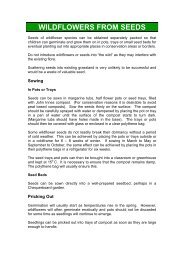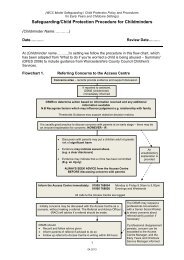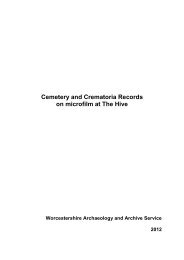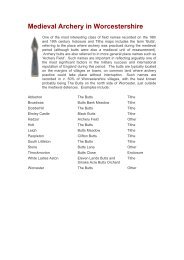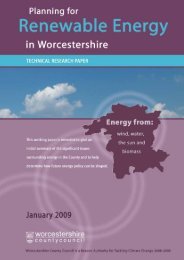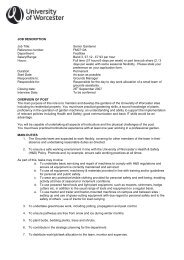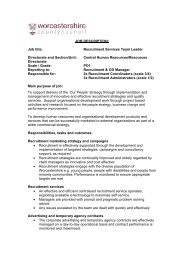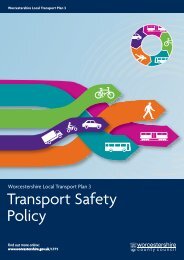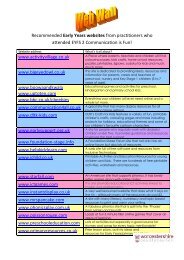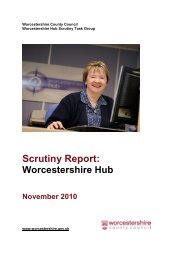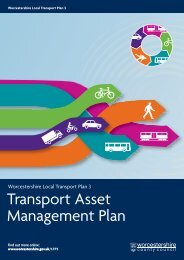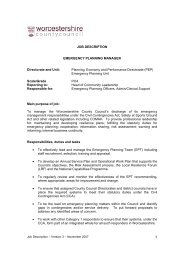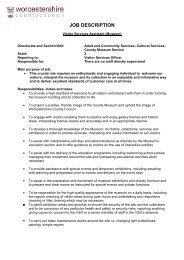Integrated Passenger Transport Policy - Worcestershire County ...
Integrated Passenger Transport Policy - Worcestershire County ...
Integrated Passenger Transport Policy - Worcestershire County ...
- No tags were found...
You also want an ePaper? Increase the reach of your titles
YUMPU automatically turns print PDFs into web optimized ePapers that Google loves.
1.2.3 Congestion, delays and unreliability on the transport network have direct costs to people andbusinesses. They increase business costs (adversely impacting productivity, productivity, availablelabour markets and innovation) and impose increased social costs. They also impact on the<strong>Worcestershire</strong> environment through issues such as air quality, carbon emissions, severance and noiseparticularly in urban areas. The passenger transport network has an important role in helping to dealwith these problems through providing a realistic alternative for journeys to/from/within congestedurban areas.1.2.4 There is a need to adopt policies that increase travel choice, encourage use of sustainable modes(including passenger transport), manage demand and make full use of existing assets. This will requirea multi-modal approach, including a package of measures that encourages use of the mostappropriate modes of transport for the various journeys which contribute toward congestion.Providing infrastructure and services which increase the use of rail, coach, bus, taxi and Community<strong>Transport</strong> will usually form a part of the package of measures.1.2.5 There is public desire (identified through a number of surveys) to improve the quality of passengertransport in <strong>Worcestershire</strong>, such that it offers a realistic alternative to the car. Examples of recentconsultation include:National Highways Best Value Benchmarking Club Survey 2008. (Approximately 800 responsesranking/rating various transport factors)<strong>Worcestershire</strong> Citizens Panel (Citizens panel survey with a section on sustainable transport,The Worcester Sustainable Travel Demonstration Town project baseline research (Results from4,250 detailed travel diaries undertaken to establish travel behaviour, Spring 2004 and 2008):o 91% of residents considered sustainable travel modes as the priority in transport policy /planning,o 87% of residents would support measures favouring public transporto 84% agreed that more improvements in favour of public transport are necessary,LTP2 ConsultationWorcester Park & Ride User Surveys (Surveys in February 2008 and July 2008, 610 responses:Worcester <strong>Transport</strong> Strategy(Questionnaire and web survey, December 2009 – March 2010) :o 87% of respondents supported proposals to improve rail station infrastructureo 82% of respondents supported encouraging greater use and improving perception ofsustainable modeso 77% of respondents supported corridor based improvements to bus infrastructure andserviceso 75% of respondents supported the use of intelligent transport systems, including real timeinformation for rail and bus userso 61% of respondents supported the provision of additional Park & Ride sites
A better environment for today and tomorrow;Economic success that is shared by all;Improving health and well being;Meeting the needs of children and young people; andStronger Communities (including housing, culture, poverty and volunteering).1.3.2 Table 1.1, below, identifies how the <strong>Worcestershire</strong> IPT <strong>Policy</strong> will contribute towards achieving thewider socio-economic objectives of the LTP3 and <strong>Worcestershire</strong> Sustainable Community Strategy.Table 1.1 – <strong>Integrated</strong> <strong>Passenger</strong> <strong>Transport</strong> <strong>Policy</strong> and How It Will Deliver Against <strong>Worcestershire</strong>Local <strong>Transport</strong> Plan 3 and Sustainable Community Strategy ObjectivesTo support <strong>Worcestershire</strong>'seconomic competitivenessand growth through deliveringa reliable and efficienttransport networkEconomic successthat is shared by allStrongerCommunitiesIPT measures will support theeconomy through:Increased accessibility to jobopportunitiesA reduction in traffic congestionby encouraging modal switching,particularly in urban areas andalong key inter-urban corridorsReducing journey times andincreased journey time reliabilityacross all modes of transportImprovements in safety andreductions in pollution.Increasing the economic viabilityand vitality of rural and urbanareas alike, making these areasmore attractive for future inwardinvestProvision of an efficient, reliable,affordable and accessiblepassenger transport network,critical to increasing transportchoice
To reduce the impacts oftransport in <strong>Worcestershire</strong> onthe local environment, byreducing noise and transportrelatedemissions of carbondioxide and other greenhousegases, with the desiredoutcomes of tackling climatechange and reducing theimpacts of transport on publichealthTo contribute towards bettersafety, security, health andlonger life-expectancy in<strong>Worcestershire</strong>, by reducingthe risk of death, injury orillness arising from transportand promoting healthy modesof travelTo optimise equality ofopportunity for all of<strong>Worcestershire</strong>'s citizens withthe desired outcome ofcreating a fairer society.To enhance the quality of lifefor <strong>Worcestershire</strong>'s residentsby promoting a healthy,natural environment,conserving our historic builtenvironment and preservingour heritage assetsA better environmentfor today andtomorrowCommunities that aresafe and feel safeStrongerCommunities Meetingthe needs of childrenand young peopleStrongerCommunitiesIPT measures will help protect thenatural environment and reducetransport related emissions byEncouraging modal switching,particularly for journeysinto/through environmentallysensitive areas.Encouraging sustainable travelchoicesIPT measures will:Encourage greater use ofpassenger transport modesReduced car dependency withconsequent reduction inaccidents and increased safetyIncrease transport choiceActively discourage inefficientuse of the networkImprove access to health carefacilities and services for allHelp promote active lifestyles/public healthIPT measures will:Improve access to workplaces,education, health, retail andleisure facilities and services forallHelp to meet the transportneeds of all social groups,including rural residentsHelp to promote a more efficientand sustainable, integratedtransport system.IPT measures will:Help protect the naturalenvironment and the historicfabric of our towns and cities, byreducing the adverse effects ofotherwise unsustainable trafficgrowth.Help to enhance overall qualityof place, and therefore quality of
life in <strong>Worcestershire</strong>.To enhance the quality of<strong>Worcestershire</strong>'s <strong>Transport</strong>Asset, through sensitive andappropriate design with thedesired outcome of reducingthe costs and inconvenienceof maintenance worksImproving health andwell being;The use of IPT measures will:Significantly enhance theefficiency of constrainedtransport networksReduce the need to constructand maintain additional highwayinfrastructureHelp reduce the overall assetmaintenance costs in<strong>Worcestershire</strong>1.4.1 This <strong>Worcestershire</strong> LTP3 <strong>Integrated</strong> <strong>Passenger</strong> <strong>Transport</strong> <strong>Policy</strong> has been developed to be fullycompliant with all current and relevant National and Local <strong>Policy</strong>. In particular, this document isaligned with the emerging Core Strategies which have been developed by the <strong>Worcestershire</strong>Borough, City and District Councils.
2.1.1 The transport fleet used to deliver <strong>Worcestershire</strong>'s passenger transport services is, like in other areasacross the UK outside of London, diverse and highly variable in terms of quality. The ability of<strong>Worcestershire</strong> <strong>County</strong> Council to influence the quality/design of rolling stock varies betweenmodes and is dependent upon detailed business cases and funding availability.2.1.2 In <strong>Worcestershire</strong>, passenger rail services are provided by four Train Operating Companies at thetime of writing: London Midland, First Great Western, Cross Country and Chiltern Railways. LondonMidland operates the majority of passenger rail services in <strong>Worcestershire</strong>.2.1.3 The rolling stock used on the Birmingham to Hereford and Birmingham to Redditch lines are generallyof a high quality, with relatively modern, high capacity commuter trains provided to operate serviceson these routes. Whilst the Stourbridge Line, which operates from Birmingham Snow Hill toWorcester via Kidderminster, is still operated with Class 150 trains, a new fleet of Class 172 trains hasbeen ordered and these are expected to take over operation of these services during the winter of2010/2011.2.1.4 First Great Western operates services between Hereford and London via Worcester and betweenGreat Malvern and Bristol (and further afield). Services to London are provided using a mix of Class165, 166 and refurbished High Speed Trains. Whilst the refurbished High Speed Trains generally offerhigh levels of passenger comfort, the class 165 and 166 trains are less suited to long distance journeys.Services between Great Malvern and Bristol are operated by a variety of refurbished ageing rollingstock, which offer variable levels of passenger comfort. Some of the older rolling stock used on thisroute are more suited to shorter distance commuting rather than long-distance journeys.2.1.5 Chiltern Railways operate peak-time services from Kidderminster to London using modern, highquality rolling stock. These train sets are fit for purpose and provide a consistently high qualitytravelling experience with high levels of passenger comfort.
2.1.6 In <strong>Worcestershire</strong>, the bus fleet is highly variable in terms of age, capacity, quality and levels ofcomfort provided. All buses in <strong>Worcestershire</strong> at the time of writing are fuelled with either diesel orpetrol. The majority of buses are single-deck vehicles, with the newest vehicles operating in the main,but not exclusively, on the high frequency (most profitable) routes. On more marginal routes, therolling stock is generally either older bus or coach stock which has 'retired' from more intensive useon urban or interurban routes. The newer vehicles tend to have low-floor capability and aredesigned to maximise passenger comfort. Double Decker vehicles are operated in Redditch and on anumber of selected school routes in <strong>Worcestershire</strong>; although <strong>Worcestershire</strong>'s generallyconstrained, historic urban street patterns are not suited to Double Decker or articulated vehicleoperation.2.1.7 The Worcester City Park and Ride routes (operated by <strong>Worcestershire</strong> <strong>County</strong> Council) use vehicleswhich meet the Euro V standard emissions. The <strong>County</strong> Council continues to encourage operators torenew older vehicles with modern fleet with cleaner, more efficient engines using a variety ofincentives.2.1.8 The taxi and community transport vehicle fleet in <strong>Worcestershire</strong> is highly variable in terms ofquality, capacity and comfort. Community transport vehicles are particularly variable, given theirspecific financial constraints and specialist requirements. These range from vehicles that arespecifically designed for purpose, such as those used by Worcester Wheels and Redditch Dial-a-Ride,to privately owned cars, such as those used by Bromsgrove Dial-a-Ride. Taxis in <strong>Worcestershire</strong> arerequired by the licensing authorities (District Councils) to have passed an MOT and to be in areasonable condition for public service. However, many taxi operators use specially procured peoplecarriers and black cabs, which, although more expensive than standard cars, can carry more personsand have additional luggage space.2.2.1 <strong>Worcestershire</strong> has a significant stock of passenger transport infrastructure, maintained by a varietyof organisations and agencies.2.2.2 Railway infrastructure in <strong>Worcestershire</strong> represents the majority of the "dedicated" passengertransport infrastructure in the <strong>County</strong>. In general, the majority of <strong>Worcestershire</strong>'s stations are'heritage' structures, which, although generally well maintained, often fall short of modernexpectations for comfort and ease of use. Urban integration with the rail network is generally good,with all of the larger settlements benefitting from access to the rail network.
2.2.3 Rail use is particularly high in the north of the county. At the time of writing (and subject to funding),there are schemes underway to significantly improve Kidderminster and Bromsgrove Stations suchthat they provide high quality multimodal interchange facilities and shop-fronts' to the railwaynetwork.2.2.4 Network Rail is developing proposals to electrify the railway from Barnt Green to Bromsgrove andmake changes to the Redditch branch (to be delivered by 2014). These projects will allow LondonMidland to operate an additional three trains per hour from Bromsgrove to Longbridge andBirmingham and one additional train per hour from Redditch to Birmingham. Network Rail is alsoincreasing capacity on the Cotswold line enabling First Great Western to operate additional railservices from <strong>Worcestershire</strong> to London.2.2.5 The Birmingham to Bristol Main Line (a key part of the strategic rail network) passes straight throughthe <strong>County</strong>. <strong>Worcestershire</strong> residents have no direct access to its services, however. This represents asignificant economic disbenefit to <strong>Worcestershire</strong>'s competitiveness (particularly in the south of the<strong>County</strong>), as poor accessibility to wider markets reduces the attractiveness of the <strong>County</strong> toprospective businesses, particularly knowledge-based industries.2.2.6 There is a significant stock of bus and community transport infrastructure in <strong>Worcestershire</strong>. Thisincludes bus stop poles and flags, bus shelters, bus lay-bys, busways, bus lanes and bus stations. Thequality of this infrastructure is highly variable, although a recent LTP2 project has resulted in many ofthe bus stops in Worcester City and some in Redditch, Wychavon and Malvern Hills being upgraded.A countywide bus stop audit was undertaken during the LTP2 plan period, which has been updated asinfrastructure has been improved.2.2.7 There is a range of potential measures that can be employed to deliver enhanced reliability andoperating speeds on the bus network. These vary according to their cost and effectiveness, and thustheir appropriateness. For example, a segregated busway (which is the highest form of bus priority,and more expensive to deliver) can usually only be justified where the levels of demand and/or thescale of the benefits to users, operators and the wider economy and environment, result in a strongbusiness case. This is only likely to be the case in congested urban areas and along key inter-urbancorridors.2.2.8 In terms of existing bus priority measures, there is a major busway in Redditch which wasincorporated into the design of the new town and enables the operation of the most efficient,heavily used and commercially viable part of <strong>Worcestershire</strong>'s bus network. Elsewhere in the countythere are a very limited amount of bus priority measures, including bus gates and bus lanes. These areprincipally in Worcester City.
2.2.9 Additional priority measures have been developed and are being installed during the LTP2 period.These are:– linking Warndon Villages and <strong>Worcestershire</strong> Royal Hospital withWorcester City Centre via Worcester Shrub Hill station and Lowesmoor.– linking Dines Green with Worcester City Centre via St John's2.2.10 In combination, these two corridors will improve the efficiency of east west bus operationsacross the city.2.2.11 Taxi infrastructure in <strong>Worcestershire</strong> is limited to taxi ranks in the larger urban areas. The linkbetween taxi rank provision and service levels is limited, with the result that in some areas, overrankingis a major issue as a result of supply outstripping available infrastructure.2.3.1 The application of transport telematics to support passenger transport users and operators has beenlimited within the county. At the time of writing, real time information has not been adopted in<strong>Worcestershire</strong>, although scheduled departure boards have been installed in the WorcesterCrowngate Bus Station and Perdiswell Park & Ride, the <strong>County</strong>'s principal bus stations and some busstops in Redditch. Additional screens are to be installed at <strong>Worcestershire</strong> Royal Hospital andRedditch Bus Station.2.3.2 Rising step barriers are in place to restrict general traffic access to and through the <strong>County</strong> HallCampus in Worcester. Transponders have been provided to the operators to equip buses thatoperate via the campus.2.3.3 Selective vehicle detection systems have been installed at a limited number of signal controlledjunctions in <strong>Worcestershire</strong>. These detect a bus upstream of the junction and amend the operationof the signals to provide priority. There is significant scope to increase the number of locationswhere this approach could be adopted and also make use of technology which can differentiatebetween buses which are operating late, on time or early, with the appropriate level of priority thenapplied.
2.4.1 In <strong>Worcestershire</strong>, at the time of writing, the majority of passenger transport ticketing is providedusing paper tickets. A number of pilots for Smartcard ticketing are either proposed or underway.Smartcards (such as London Oystercard) are pre-paid stored value cards which enable holders toeasily pay-as-they-go, travelling on passenger transport networks using a variety of modes.2.4.2 Concessionary travel is provided for the young people and persons aged over 60 through a variety ofspecialist schemes which cover rail, bus and some community transport operations.2.4.3 Apart from the rail ticket issuing systems, the majority of passenger-transport ticketing operations in<strong>Worcestershire</strong> are "non-secure", i.e. they rely on staff and passenger honesty to prevent fraud.Unfortunately, fraud is and continues to be an issue, acting as one of the barriers to intermodalintegration. The introduction of a secure multimodal smartcard ticketing system would resolve this.The cost and complexity of these systems are significant, however.2.4.4 Rail ticketing and fares are managed by Train Operating Companies on behalf of the DfT. Fares areset by the individual train companies, but in many cases these are regulated by the DfT. The railticketing system is fully secure, tickets can be purchased in advance or on the day at self-serviceticketing machines, on the train or at a manned ticket office.2.4.5 A smartcard system is being trialled on the Stourbridge Line at the time of writing, which coversWorcester, Droitwich, Hartlebury, Kidderminster, Blakedown and Hagley Stations. The Departmentfor <strong>Transport</strong> are committed to widespread rollout of smartcard ticketing across the rail network fornon-advance purchase tickets.2.4.6 The expansion of the West Midlands Penalty Fares Ticketing Zone now covers most of<strong>Worcestershire</strong>'s rail network, which requires all passengers to buy a ticket before they travel.Honeybourne, Pershore and Evesham Stations are exempt from this scheme.2.4.7 The rail industry provide a range of concessionary fares cards, which entitle holders to significantdiscounts (up to a third) off the price of a standard ticket. These cards include:Senior Railcard (60+)Young Persons Railcard (16-25)Family Railcard (up to four adults and four children)Disabled Persons RailcardHM Forces RailcardNew Deal Photocard (Unemployed persons)
2.4.8 At the time of writing, bus, community transport and taxi ticketing in <strong>Worcestershire</strong> are almostentirely provided at the point of sale by the driver of the vehicle. On-bus ticket machines generallyprovide limited data collection opportunities which identify the amount of tickets sold by passengertype, but specific details of where passengers alight and depart is not collected. Those tickets whichare not sold at the point-of sale are issued from either a small number of newsagents and kiosks in<strong>Worcestershire</strong> which sell monthly and annual bus tickets, or directly from the bus operators viatelephone or post.2.4.9 Off-bus ticket machines are provided at both the Perdiswell and Sixways Park & Ride sites inWorcester. These machines are linked to the operation of the barriers controlling access to and exitfrom the Park & Ride car parks. However, both machines can issue travel-only tickets.2.4.10 A smartcard ticketing trial is proposed for some bus services in Redditch, however, the adoption oftechnologically advanced ticketing in <strong>Worcestershire</strong> has been slow due to the complexity and costsof implementing such systems. In general, bus, taxi and community transport ticketing systems andfares are set by the operators, although there is some regulation of fares on those passengertransport services that are subsidised by <strong>Worcestershire</strong> <strong>County</strong> Council. Taxi fares are subject to amaximum fare, which is set by the licensing authority (in <strong>Worcestershire</strong>, this role is performed bythe Local Planning Authorities). There is very little integration of ticketing arrangements, with themajority of tickets issued exclusively valid on a single operator's services.2.4.11 The English National Concessionary Travel Scheme (ENCTS) entitles all persons aged over 60 to travelfree on buses in England and Wales. This statutory scheme is currently administered by the DistrictCouncils in <strong>Worcestershire</strong>, although recent legislative changes now mean that control of thisscheme will be transferred to <strong>Worcestershire</strong> <strong>County</strong> Council in the near future.2.4.12 There are no statutory concessionary fares for young people; however, the majority of operatorsprovide child fares for persons aged under 16. <strong>Worcestershire</strong> <strong>County</strong> Council also operates theSevern Card scheme, which provides unlimited student travel on multiple operators' services forthose aged under 19 years old.2.4.13 Recent legislation changes have provided a more flexible legal framework which allows for greaterintegration of road-based passenger transport tickets. It is generally accepted that a technologicalapproach to integration (using smartcard technology) is the most appropriate means of achievingthis. Any solution that is identified for <strong>Worcestershire</strong> must, however, meet all user requirements,including being affordable to the users and administrators of such a scheme.
2.5.1 The existing passenger transport service provision is clustered along the main interurban routes andthe main urban radial corridors. The key issues include:Rail provides (with a few exceptions such as the 44 & 144 bus routes) the most consistenttimetables and attractive journey times for interurban travel across the countyLocal bus provides the primary urban passenger transport provision across the countyThe passenger transport frequency of service and periods of operation in urban areas is highlyvariable, leading to patchy performance in terms of offering an attractive alternative to the carfor journeys in congested urban areas. This is caused by a variety of factors.2.5.2 The level of service provided by the rail network in <strong>Worcestershire</strong> is generally adequate to meetexisting demand, with all larger urban areas having access to the local/regional rail network (with theexception of the Bristol – Birmingham Main Line). The rail services which serve <strong>Worcestershire</strong> are asfollows:Hourly service between Hereford and Birmingham. This calls at the following <strong>Worcestershire</strong>stations: Great Malvern, Malvern Link, Worcester Foregate Street, Worcester Shrub Hill (peaktimes only), Droitwich Spa and Bromsgrove (limited at peak times).Hourly service between Stratford upon Avon and Birmingham. This calls at Wythall in<strong>Worcestershire</strong>.30 minute service frequency between Worcester, Stourbridge and Birmingham, with limitedservices extending as far as Great Malvern. This calls at: Great Malvern (only certain services),Malvern Link (only certain services), Worcester Foregate Street, Droitwich Spa, Hartlebury (onlycertain services), Kidderminster, Blakedown and Hagley. Generally this service operates every 15minutes between Kidderminster to Stourbridge and Birmingham.30-minute service frequency between Redditch, Birmingham and Lichfield. This service calls atthe following <strong>Worcestershire</strong> stations: Redditch, Alvechurch and Barnt Green.12-15 services daily between Hereford and London Paddington. These call at the following<strong>Worcestershire</strong> stations: Great Malvern, Malvern Link, Worcester Foregate Street, WorcesterShrub Hill, Pershore, Evesham and Honeybourne.A service every 2 hours between Great Malvern and Bristol Temple Meads. This calls at: GreatMalvern, Malvern Link, Worcester Foregate Street and Worcester Shrub Hill.Five trains a day between Kidderminster and London Marylebone. These services call at thefollowing <strong>Worcestershire</strong> stations: Kidderminster, Blakedown and Hagley.Cross Country operate two trains per day between Bromsgrove and Birmingham
2.5.3 Bus services form the backbone of the passenger transport network in <strong>Worcestershire</strong>, carryingapproximately 17.5 million passenger journeys annually. At the time of writing, there wereapproximately 160 registered bus services, although levels of service are highly variable around thecounty, with the most frequent services provided on key urban and interurban routes. Furtherinformation on bus demand and operation is provided in the LTP3 Essential References document.2.5.4 Taxi services in <strong>Worcestershire</strong> are clustered in the main urban areas, although taxi ranks are spreadacross urban areas. These services can be procured remotely or at specified taxi ranks and generallycover the full county area. Provision of infrastructure to support taxi operation across the county ispoorly integrated with other modes of transport.2.5.5 Community transport services in <strong>Worcestershire</strong> cover both rural and urban areas with usuallybespoke conditions of use (e.g. eligibility) and periods of operation. These services are procuredremotely (normally by telephone) and provide door-to-door accessibility for those who are unableto access conventional passenger transport options (with the exception of taxi services) for a varietyof reasons.2.6.1 Delays and unreliability on the transport network have direct costs to people and businesses. Theyincrease business costs (adversely impacting productivity, productivity, available labour markets andinnovation) and impose increased social costs (such as reduced family time and decreased leisuretime), which can have adverse impacts on public health and overall quality of life. Withoutinvestment, the passenger transport network is not immune from the effects of capacity constraintsand congestion. An efficient, reliable and competitive passenger transport network is required tohelp deal with the adverse impacts of congestion on <strong>Worcestershire</strong>'s economy.2.6.2 For passenger transport to offer an attractive alternative to the convenience of the car, it must beable to compete effectively in terms of total journey times, reliability and journey costs. On the railnetwork capacity pinch points, line speed restrictions and other infrastructure and rolling stockrelatedconstraints adversely impact on journey times and service reliability. Traffic congestion inurban areas and along key inter-urban corridors allied to infrastructure which fails to protect roadbasedpassenger transport users and operators undermine the journey times and (critically) thereliability of coach, bus, community transport and taxi operations.
2.6.3 Rail is generally regarded as one of the most reliable modes of passenger transport in terms of thelevels of punctuality and reliability that it provides. The reliability and punctuality of rail services is amajor franchise commitment for the Train Operating Companies, with the DfT retaining a closewatch on the performance. Where performance drops below a certain level, the DfT can issuepenalties to enforce investment in services and infrastructure. In general, rail operationalperformance in <strong>Worcestershire</strong> continues to gradually improve, particularly where investments havebeen made in new rolling stock and infrastructure enhancement.2.6.4 The operational performance (punctuality and reliability) of <strong>Worcestershire</strong>'s bus network continuesto be heavily affected by peak time congestion, particularly in <strong>Worcestershire</strong>'s urban areas. Thiscauses a range of significant disbenefits including:Deterioration in public perception of passenger transport as a viable (reliable) option for travelIncreased congestion as passengers switch to the car as a more reliable journey optionReduced demand for bus travel, leading to:o Falling revenueso Deteriorating commercial performanceo Increased subsidy to maintain the network OR poorer or withdrawn servicesReduced operational efficiency of bus services which causes:o Increased costso Reduced service provision (network attrition)2.6.5 Currently <strong>Worcestershire</strong> performs poorly in terms of punctuality in terms of both frequent andnon-frequent services. There is scope for significant improvement. This will require a strongpartnership approach between the private sector bus companies (as the operators of the services)and <strong>Worcestershire</strong> <strong>County</strong> Council (as the primary provider of transport infrastructure).
2.7.1 Procurement arrangements are generally mode specific, with a complex range of procurementmethods used for the various networks.2.7.2 Rail franchises are procured directly by the DfT. This franchising process is carefully managed tomaximise investment in the railway and to provide value for money. The franchises in <strong>Worcestershire</strong>as follows:Chiltern Railways Deutsche Bahn 1st April 2002 31st March 2022Cross Country Arriva 11thNovember 2007 31stMarch 2016First Great Western First Group 1stApril 2006 31stMarch 2016London Midland Govia 11thNovember 2007 19thSeptember 20152.7.3 <strong>Policy</strong> relating to the provision of rail franchises is likely to change under the Coalition Government,however, it can be seen from the table above that 2015/2016 presents an important opportunity togenerate improvements to the rail network in <strong>Worcestershire</strong>.2.7.4 Bus services operated under tender to <strong>Worcestershire</strong> <strong>County</strong> Council are now procured using theinnovative e-tendering process, which requires all prospective operators to join a pre-qualifyingframework, prior to being able to bid for tendered services. The operators then engage in a biddingprocess, with the winning bid chosen according to its compliance with pre-specified tender criteria(which can include facets such as quality and cost).2.7.5 Taxis and community transport services are procured directly by users in <strong>Worcestershire</strong>. At the timeof writing, some taxi firms bid for education and social service contracts through the <strong>Worcestershire</strong>e-tendering process. Community transport operators do not currently bid for contracts through thee-tendering process.
2.8.1 Driver standards for passenger transport services are currently monitored and managed by thepassenger transport operators. In the case of buses, tendered services may specify requirements fordriver training and courtesy, however, the quality of driver resource in the county remains variable.2.9.1 The marketing of passenger transport and provision of information is currently undertaken by theoperators and <strong>Worcestershire</strong> <strong>County</strong> Council through their respective websites, the local media,and published material. The <strong>Worcestershire</strong> <strong>County</strong> Council provides the central portal formultimodal passenger transport information in the <strong>County</strong> at www.worcestershire.gov.uk/transport.This website provides a series of passenger transport maps, timetables and a journey planner,together with links to national resources, providing a one-stop-shop for passenger transportinformation in <strong>Worcestershire</strong>. In addition, passenger transport information is disseminated to all<strong>Worcestershire</strong> Hub locations and local libraries, where computers are available for the generalpublic to access the <strong>Worcestershire</strong> <strong>County</strong> Council website.2.9.2 In addition, there is, at present, limited provision of scheduled bus information provided at bus stops.<strong>Transport</strong> operators and Local <strong>Transport</strong> Authorities strive to deliver passenger transport informationfor all modes at the <strong>County</strong>'s rail, bus and coach stations; however, it is acknowledged that there aregaps in provision. A programme to refit the majority of bus stops in Worcester City to provideenhanced passenger transport information has been recently delivered, which has significantlyimproved the quality of information available at bus stops in the city. More heavily used bus stopflags have their Traveline unique identifier codes which enable travellers to text or ring the nationalTraveline service for real time information. However, despite this, passenger transport information atbus stops generally remains at a poor standard countywide. Information on taxis is available onwebsites and in the phone book, however, specific information and signage in town and city centresidentifying the location of taxi ranks is poor, lacking coordination.2.10.1 <strong>Worcestershire</strong>'s passenger transport networks perform a vital role in the enhancement ofaccessibility to key services and facilities essential for quality of life. Significant work has taken placeto understand existing accessibility levels and to improve future accessibility to key services andfacilities for existing and planned residential areas. The <strong>Worcestershire</strong> LTP3 <strong>Transport</strong> Accessibility<strong>Policy</strong> details the progress that has been made to date, together with the way in which accessibilitymapping in <strong>Worcestershire</strong> will be developed during the LTP3 plan period. Accessibility planning willcontinue to provide a powerful tool to measure the effectiveness of the passenger transportnetworks in <strong>Worcestershire</strong> as a means of enhancing social cohesion and economic vitality in the<strong>County</strong>, enabling robust technical justification for enhancement (essential when bidding for fundingfor passenger transport infrastructure and services).
3.1.1 The <strong>Worcestershire</strong> IPT policy has a strong role to play in the delivery of the LTP3 objectives andother relevant local and national outcomes. This section considers in more detail how the applicationof IPT policies in <strong>Worcestershire</strong> will support these outcomes through the delivery of the integratedpassenger transport vision (previously agreed for the LTP2 <strong>Integrated</strong> <strong>Passenger</strong> <strong>Transport</strong> Strategy).3.1.2 The overarching vision of the <strong>Worcestershire</strong> <strong>Integrated</strong> <strong>Passenger</strong> <strong>Transport</strong> <strong>Policy</strong> is to provide for<strong>Worcestershire</strong>:3.1.3 The delivery of this vision will require improvements to the passenger transport network. Specificallythe integrated passenger transport system must be:Aligned with travel demand: High quality passenger transport infrastructure and servicesalong key corridors of demand (urban & inter-urban)Accessible: Improved passenger transport accessibility, in terms of:Physical access to the network, infrastructure and vehicles,Availability of services to access key services and facilitiesAvailability to the widest cross section of the populationSafe: A safer network, with improved facilities for users at stations, stops and on vehicles(including CCTV and information)Reliable: A more reliable network with passenger transport services protected from theeffects of congestion with reductions in journey times, increasing the competitiveness ofpassenger transport<strong>Integrated</strong>: A more integrated network in terms of information, ticketing and operationsEquitable and inclusive: A more accessible networkEasy to understand and use: Better information for users, including real time informationsystems, the internet and at-stop/station informationReflective of modern lifestyles: More convenient passenger transport services withperiods of operation aligned with the needs of usersModern and attractive: Better, more environmentally friendly and accessible vehicles andinfrastructureAffordable and Value for Money: A more efficient, cost effective network with reductionsin time spent in congested conditions providing better value for money for passengertransport users
3.1.4 The provision of an integrated passenger transport network of this kind is neither urban nor ruralspecific. The methods of achieving the vision will differ between urban and rural environments and<strong>Worcestershire</strong> <strong>County</strong> Council and its partners will use the most appropriate range of infrastructure,operational, technological, resources and information measures available to them.3.1.5 The aim is to deliver an integrated network of services which will grow the market for passengertransport for journeys within and to/from <strong>Worcestershire</strong>. This will require making the productattractive both to existing and potential users alike. It will achieve significant improvement in theprovision of passenger transport services and facilities to the people of <strong>Worcestershire</strong> by followinga customer-driven approach designed to identify and overcome barriers to the use of passengertransport. The provision of effective and attractive passenger transport links to key locations ofemployment, health, education, retail, transport interchanges and leisure will be a key element in thestrategy.3.1.6 The strategy takes account of the opportunities and constraints (financial and capacity-related) ofthe expansion of passenger transport concessionary travel opportunities. In particular, theenhancement of accessibility offers an opportunity to increase usage of passenger transport by theconcessionary travel market, with consequent social, economic and financial benefits for<strong>Worcestershire</strong>.3.1.7 The vision can only be achieved in partnership with all those involved in passenger transportprovision, including rail, bus and coach operators, community transport providers, taxi operators andthose responsible for passenger transport procurement and infrastructure.3.2.1 <strong>Worcestershire</strong>'s <strong>Integrated</strong> <strong>Passenger</strong> <strong>Transport</strong> Network will be designed to meet the objectivesand produce the desired outcomes specified in Sections 1 and 2. This will involve the iterativeapproach outlined in Table 3.1.
Table 3.1 – <strong>Integrated</strong> <strong>Passenger</strong> <strong>Transport</strong> Network Development and Delivery Process Flowchart3.2.2 This <strong>Integrated</strong> <strong>Passenger</strong> <strong>Transport</strong> <strong>Policy</strong> will be refreshed as required to respond to changes incircumstance during the life of the LTP3 Compendium. Whilst this process is being undertaken it isimportant to confirm that the existing network will be maintained and managed as appropriate, withefficiencies and improvements being sought on an ongoing basis.<strong>Worcestershire</strong> <strong>County</strong> Council will work with partners to define an integrated passengertransport network for the county, following a robust and iterative approach.This process will make full use of available data and transport models, the LTP3 Scheme AppraisalFramework and will be fully integrated with the LTP3 consultation process, including working withprivate and public sector partners.
3.3.1 It is important that investment in the passenger transport network is aligned with existing andforecast travel demand. This is likely to be particularly important during the LTP3's first Delivery Planperiod when available finance is likely to be extremely limited.3.3.2 There is clear evidence that a high-performing passenger transport system is an important enabler ofsustained economic prosperity as it can help to reduce congestion particularly in urban areas andalong key inter-urban corridors. <strong>Passenger</strong> transport networks also support the productivity andsuccess of urban areas and their catchments, by getting people to work, supporting deep andproductive labour markets and allowing businesses within the area to reap the benefits ofagglomeration.3.3.3 The greatest value for money in terms of return on investment in passenger transport will be thoseprojects and schemes which:Support the economy and economic growthEnable the transport network to operate more efficiently and reduce or remove the transportconstraints which inhibit the performance of the economy, in particular:o In congested urban areaso Along key inter-urban corridorsSupport better use of the existing network, particularly the busier parts of that networkHelp to unblock key pinch points<strong>Worcestershire</strong> <strong>County</strong> Council will prioritise investment toward passenger transport schemeswhich:Are aligned with travel demandSupport the performance of the economyOffer the greatest return on investmentEnhance the overall commercial viability of the network (and hence reduce the need forpublic subsidy)This is likely to involve prioritising investment:In congested urban areasAlong key inter-urban corridors
3.4.1 Accessibility, in general terms, is used to describe the ease by which people can access locations,facilities and services. In terms of passenger transport the quality of accessibility is influenced by thephysical ability to use this mode of transport to access a location, facility or service and the totaltravel time and cost associated with the journey.3.4.2 The delivery of improved levels of passenger transport accessibility over the LTP3 period is a coreelement of the <strong>Worcestershire</strong> IPT <strong>Policy</strong>. Accessibility planning techniques will be used to shape aneffective, deliverable and sustainable passenger transport network for <strong>Worcestershire</strong>, which willenhance the performance of the economy by getting people to work and supporting deep andproductive labour markets. This will also improve the quality of life of residents, through helping tomeet their accessibility needs and in improving their environment.3.4.3 Accessibility planning must strongly influence the design of the passenger transport network. Inparticular it has close links with infrastructure, rolling stock, bus & community transport networkdesign, priority measures and fares & ticketing.3.4.4 Successful accessibility planning has been proven to deliver the following key benefits:Improved accessibility by passenger transport to key services and facilities, with effectivemeans of quantifying existing and projected accessibility levels.More effective integration between new land use developments and passenger transportservices, delivering more sustainable developmentsModal shift leading to reduced congestion in support of the economy and environmentA more commercially viable <strong>Passenger</strong> <strong>Transport</strong> Network, as a result of the increasedcompetitiveness of passenger transport, with a reduction in need for public subsidyImproved network planning and performance management, as accessibility planning allows forimpact testing of infrastructure and network enhancements.Enhanced network development opportunities, as accessibility mapping provides soundevidence of the effectiveness of measures to enhance
<strong>Worcestershire</strong> <strong>County</strong> Council will take full account of the accessibility delivered by thepassenger transport network. In particular, it will seek, subject to funding availability, to ensurethat all key employment, health, education, retail and leisure services and destinations in<strong>Worcestershire</strong> are provided with a level of accessibility by passenger transport which:Ensures that those without access to a car are not disadvantaged in terms of ability toaccess these key services, facilities and employment and training opportunitiesEnsures that passenger transport is a realistic alternative to the car (in terms of actualand perceived journey times and costs), particularly for journeys in to/from/withinurban areas and along key inter-urban corridorsSupports the achievement of the public transport mode shares which underpin existingand proposed Travel PlansWhere mobility impairments prevent residents from using conventional passengertransport services, alternative transport options are made available (such as communitytransport, ambulances or taxis) or the services are delivered to residents throughinnovative solutionsAccessibility assessments will be undertaken to an appropriate level of detail as part of allassessments of justification of changes to the passenger transport network (infrastructure andservices).3.5.1 It is vital that <strong>Worcestershire</strong>'s passenger transport network is safe for users and operators. Thisincludes people's perception of the safety of using or operating the network as this will influencebehaviour, choice of travel mode and quality of life. Users and potential users of passenger transportservices must feel secure through measures such as:Safe routes to rail, bus and taxi stops and stations and within multi-modal interchangesAdequate lighting at interchanges and train, bus and taxi stops and stationsModern rolling stock/vehicles meeting appropriate design standards, with adequate security,lighting and information systems for users and operating staffUp-to-date and easily understood information on passenger transport services and facilities,this will include real time information where the level of demand can justify the capital andoperating costsCCTV at major passenger transport stops, stations and interchanges where the level of demandcan justify the capital and operating costsMore reliable and punctual services, reducing user uncertaintyCRB checked operating staff (including passenger transport drivers and other public facingoperating staff)
<strong>Worcestershire</strong> <strong>County</strong> Council will work with passenger transport operators and infrastructureproviders to provide a network of infrastructure and services that meet relevant safety andDisability Discrimination Act requirements and increases user confidence.We will seek in partnership with the private and voluntary sectors (and subject to fundingavailability) to deliver the quality of infrastructure and vehicles which:Meet the appropriate infrastructure quality standards set out in the Bus InfrastructureDesign GuideMeet the appropriate vehicle quality standards set out in this documentProvide value for moneyTake account of the needs of more vulnerable sections of our community, such theyoung, elderly and mobility impairedEnsures that those without access to a car are not disadvantaged in terms of actual orperceived safety when seeking to access key services and facilitiesIs in line with seeking to ensure that passenger transport is a realistic alternative to thecar), particularly for journeys to/from/within urban areas and along key inter-urbancorridors3.6.1 Delays and unreliability on the transport network have direct costs to people and businesses,increasing business costs and adversely impacting productivity, productivity, available labour marketsand innovation. An efficient, reliable and competitive passenger transport network is required to helpdeal with the adverse impacts of congestion on <strong>Worcestershire</strong>'s economy.3.6.2 Unreliable and "slow" services have the effect of discouraging use of passenger transport by thosewho have a choice of transport modes. Reliability problems also impose direct costs on operators interms of requiring additional resources to operate a given service (with the costs passed on to theuser via increased fares) and indirect costs in terms of reduced revenues due to lower levels ofdemand resulting from a less reliable service. Alternatively an operator may choose to withdraw oroperate a lower level of service (reduced frequency or period of operation) as a means of minimisingcost increases. Public subsidy is then required to maintain an acceptable level of service.3.6.3 Thus, a slow and unreliable passenger transport network usually results in:Increased costs (for operator and user)Reduced levels of service (unless service is subsidised by the public sector)Reduced demand and revenueIncreased dependence of passenger transport on its ‘captive’ user market (concessionary traveland no car households) for its demand and revenuesIncreased dependence on non-passenger transport modes (especially the car) to provideaccess to key services and facilities
Increased congestion, particularly in urban areas and along key inter-urban corridors3.6.4 The aim of the LTP3 is to move away from this downward spiral and to develop a network of fast,reliable and integrated services for <strong>Worcestershire</strong>. In order to deliver this, it will be necessary forpassenger transport services to operate reliably, punctually and with consistently quick journey timesto deliver a network which offers a realistic alternative to the car. There is clear evidence (in<strong>Worcestershire</strong> and elsewhere) that this approach delivers real benefits.<strong>Worcestershire</strong> <strong>County</strong> Council will work with passenger transport operators and infrastructurepartners to obtain the funding required provide the infrastructure and other measures requiredto deliver a network of reliable passenger transport services with consistently quick andcompetitive journey times, particularly for journeys:In congested urban areasAlong key inter-urban corridorsFor rail, this will involve working with rail industry partners and key funding bodies such as theDepartment for <strong>Transport</strong> to identify and resolve capacity pinch points, line speed problemsand rolling stock capacity restrictions.For bus, this will involve working with partners to develop meaningful quality partnershipswhich:Establish evidence based reliability and journey time targetsDeliver infrastructure, operational management measures and Traffic Regulation Orderswhich will deliver against these targetsEnsure that measures are properly enforcedMonitor performance (including enforcement)For community transport, this will involve working with operators to identify existing reliabilityconstraints on the network, and seeking to mitigate these issues to enhance the efficiency ofthese operations (such as drop off points at key trip attractors such as hospitals)For taxis, this will involve working with operators to ensure that provision and use ofinfrastructure is optimised to ensure that this mode integrates properly with other modes oftransport.3.7.1 The passenger transport network must be integrated if it is to deliver higher levels of accessibilityand transport choice to the community. It is essential that passenger transport must be integratedwith new land use developments from the outset of the planning process and that information &marketing, infrastructure, fares & ticketing and operations are also well integrated.
3.7.2 New developments, particularly of larger scale, must have high levels of passenger transportaccessibility and should be designed to encourage use of all sustainable transport modes. Theaccessibility needs of these transport modes must be considered at the outset of the developmentplanning and design process. In practice, this will require measures such as:Short (
3.7.5 The passenger transport network for journeys to/from and within <strong>Worcestershire</strong> is delivered by arange of road and rail-based passenger transport modes and service providers. Integration within thepassenger transport network is essential if travel opportunities are to be maximised. In practice thisrelates primarily to passenger transport information & marketing, interchange infrastructure, fares &ticketing and timetable co-ordination.3.7.6 In terms of integration between passenger transport modes and subject to legislative constraints,<strong>Worcestershire</strong> <strong>County</strong> Council will encourage the passenger transport operators to co-ordinatetheir services in terms of information & marketing, infrastructure, timetables and vehicles/rollingstock. The aim being to ensure that passengers are able to interchange easily between passengertransport services in a seamless way and with minimal additional cost.3.7.7 It should be noted that current legislation contains some powers for local transport authorities toinfluence the development of truly integrated passenger transport services, particularly in terms offares & ticketing. Allied to advances in ticketing and information technology this will be used toenable better integration of passenger transport over the LTP3 period.3.7.8 The passenger transport network must be integrated with the wider transport network. It must offeropportunities for car users to interchange with passenger transport services in a seamless way. Thiswill help to reduce congestion in urban areas and along key inter-urban corridors.3.7.9 The provision of large and small scale interchanges will be investigated where these offer theopportunity to encourage use of passenger transport for those sections of journeys (such as intocongested urban areas or along key inter-urban corridors) where this offers the most efficient use ofresources and network capacity. Rail, coach and bus Park & Ride, Parkway and Coachway facilities aregood examples of this kind of interchange.<strong>Worcestershire</strong> <strong>County</strong> Council will work with passenger transport operators, infrastructureproviders and land use planners to:Integrate passenger transport with new land use developments from the outset of thedevelopment planning processEnsure integration within and between passenger transport modes, particularly in terms ofinformation & marketing, fares and ticketing, infrastructure provision, timetables and rollingstock/vehiclesBetter integrate passenger and private transport modes, particularly in terms of theprovision of large and small scale multi-modal interchanges where these encourage greateruse of passenger transport in congested urban areas and along key inter-urban corridorsWork with partners to ensure that key multi-modal interchanges such as rail stations andPark & Ride are provided with adequate and appropriately priced car parking whichencourage use of passenger transport
3.8.1 To be equitable and inclusive the passenger transport network must ensure that <strong>Worcestershire</strong>residents and businesses have access to key services. It is important that those without access to acar are not disadvantaged in terms of ability to access key employment, education, health, retail andleisure facilities, services and opportunities. This requires improved levels of passenger transportaccessibility which is a core element of the <strong>Worcestershire</strong> IPT <strong>Policy</strong> (see <strong>Policy</strong> IPT3).3.8.2 The cost of travel by passenger transport is also a key consideration in terms of delivering anequitable and inclusive network. The ability of <strong>Worcestershire</strong> <strong>County</strong> Council to influence the faresset by private sector passenger transport operators is constrained by legislation. The county councilwill, however, work in partnership with operators to influence the costs of using passenger transportand also encourage the development of multi-operator inter-available ticketing. The opportunitiesprovided through the advances in ticketing and information technology will be explored and used tothe fullest extent where these are shown to offer value for money.<strong>Worcestershire</strong> <strong>County</strong> Council will work with partners to deliver a passenger transport networkwhich provides <strong>Worcestershire</strong> residents and businesses with access to key services. In particular,it will seek to ensure that all key employment, health, education, retail and leisure services anddestinations in <strong>Worcestershire</strong> are provided with a level of accessibility by passenger transportwhich ensures that those without access to a car are not disadvantaged in terms of ability toaccess these key services, facilities and employment and training opportunities.3.9.1 Providing accurate, easily understood and accessible information on the passenger transport networkplays an essential role in the public perception of passenger transport. Where conducted effectively,information provision delivery generates the following key benefits:Increasing public confidence in the passenger transport networkIncreased patronage across passenger transport networks (increasing the financial sustainabilityof the network)Reduction in congestion due to modal switching, particularly for journeys in congested urbanareas and along key inter-urban corridorsImproved information dissemination to the public on passenger transport networkdevelopments and enhancementsIncreased reassurance to members of the public during any periods of service disruptionDevelopment of a prestigious image of the passenger transport network3.9.2 Key to the delivery of this are:A clearly defined and understood "brand" for the <strong>Worcestershire</strong> passenger transport network
Best practice design and content of passenger transport information, following, for example,the Association of <strong>Transport</strong> Coordinating Officers Code of Good PracticeLimiting to the minimum the number of timetable changes per year (frequent timetablechanges jeopardise the quality of information, increase costs and cause public confusionWorking with passenger transport operators to deliver a stable, easily understood network forusers, supported by comprehensive network information such as maps and diagramsWorking in partnership with passenger transport operators to information on timetables,routes and fares to an agreed uniform best practice standard, to build user confidence in theirplanned journey.<strong>Worcestershire</strong> <strong>County</strong> Council will work with passenger transport users and operators and otherpartners to:Develop a clearly defined and understood "brand" for the <strong>Worcestershire</strong> passengertransport network, used consistently on <strong>Worcestershire</strong>'s infrastructure and servicesEnsure that information on passenger transport meets recognised best practiceguidelines in terms of design, content and distributionCo-ordinate and limit to a minimum the number of timetable changesImprove the quality of map based passenger transport network informationProvide a consistent quality of electronic (website), interchange, rail & bus station androadside informationDeliver real time information on high demand sections of the network where a strongbusiness case can be developedInclude within all Quality Partnerships (see also IPTP 15) specific reference informationstandards, branding and associated maintenance requirementsSubject to the availability of funding and resources, <strong>Worcestershire</strong> <strong>County</strong> Council will considertaking on responsibility for the provision of road side information if this will ensure consistencyand quality.3.10.1 A passenger transport network capable of supporting the economic and social well being of<strong>Worcestershire</strong> must be convenient and attractive to use, particularly for those with access to a carand in areas where mode switching to passenger transport is important, such as congested urbanareas and along key inter-urban corridors.
<strong>Worcestershire</strong> <strong>County</strong> Council will work with passenger transport operators, infrastructureproviders, land use planners and private sector businesses and developers to:Ensure that new developments consider from the outset the need to provide access topassenger transport services that are convenient and attractive to use.Improve the convenience of the existing network, particularly in congested urban areasand along key inter-urban corridors3.11.1 It is essential that the efficiency of the passenger transport network is maximised within givenfunding constraints. The LTP3 and IPT approach to the appraisal of transport schemes enables costsand benefits to be explicitly taken into account. This will help to ensure that <strong>Worcestershire</strong> achievesa sustainable passenger transport network which delivers on a range of socio-economic benefits.3.11.2 In transport there are two main types of funding requirements:Revenue funding, which meets the day-to-day costs of providing services, and is derived fromthe <strong>County</strong> Council’s funds and Rural Bus Subsidy Grant.Capital funding, which meets the cost of investments in infrastructure intended to improve theefficiency and use of passenger transport and is drawn from the Local <strong>Transport</strong>Plan/<strong>Integrated</strong> <strong>Transport</strong> Block settlement and any additional funding bids, e.g. Major SchemeBids), the Department for <strong>Transport</strong> [Rail], Network Rail, Private Sector (Developer)contributions etc.
3.11.3 Revenue funding tends primarily to provide accessibility benefits by enabling provision of sociallynecessary passenger transport services. Nevertheless, all supported services do make a significantcontribution to congestion relief particularly in relation to support for Park and Ride services, schooltransport, social care transport and other services operating at peak hours. Revenue funding is alsoused to support the concessionary travel scheme and to maintain road based passenger transportinfrastructure.3.11.4 The investment of capital funds into road and rail based passenger transport infrastructure is key todealing with the key "pinch points" on the network such that the efficiency and quality of service isimproved (particularly in terms of reliability and journey times). This is particularly important in urbanareas and along key inter-urban corridors where a realistic alternative to the car needs to beprovided to deal with congestion and support the economy.3.11.5 Capital investment can also address accessibility issues (e.g. purchase of accessible vehicles,investment in multi-modal interchanges and rail, bus and coach stops and stations to improve accessto the network), passenger information (e.g. through investment in real time information systems)and fares and ticketing issues (e.g. through investment in off-vehicle ticketing and payment systemssuch as smartcards).3.11.6 Well targeted capital investment will both help to attract additional demand (and revenue) andincrease the efficiency (and hence reduce the operating costs) of the passenger transport network.Where such investment is supported by meaningful partnership agreements between the public andprivate sectors, this efficiency improvement can be fed back to the user in the form of reduced faresand/or higher levels of service.<strong>Worcestershire</strong> <strong>County</strong> Council will work with passenger transport operators, infrastructureproviders, funding bodies and private sector businesses and developers to:Maximise the value for money of capital and revenue investment in the passengertransport infrastructure and services.Identify the "pinch points" which reduce the efficiency and quality of servicesDevelop robust bids for capital and revenue funding investment in <strong>Worcestershire</strong>'spassenger transport infrastructure and services to address identified problems andopportunitiesEstablish meaningful partnership arrangements whereby efficiency savings are passedback to <strong>Worcestershire</strong> residents and businesses in the form of reduced fares and/orimproved levels of service agreed between the partners as being most appropriate
4.1.1 Central to the <strong>Worcestershire</strong> ITP <strong>Policy</strong> is the delivery of an integrated network that is fit forpurpose in terms of achieving high levels of accessibility, providing real transport choice (particularlyin congested urban areas and along key inter-urban corridors) and offering value for money for usersand funders. To achieve this requires recognition of the strengths, weaknesses and role of eachpassenger transport mode and the subsequent targeting of scarce public and private sectorresources toward the achievement of a network which offers the best business case and a high valuefor money.4.1.2 The approach must be modally agnostic, that is to say, in each case; the network has to use the mostefficient mode of transport according to existing and projected demand, balanced with availablecapital and revenue funding. Table 4.1 identifies the model which considers passenger transportmodal provision, taking account of demand, performance and costs (capital and revenue).Table 4.1 – <strong>Worcestershire</strong> Approach to Modal ProvisionName Description RoleAverageSpeedLevel of TravelDemand to JustifyInvestment(<strong>Passenger</strong>s/Hour/Direction)InfrastructureCostsOperatingCostsHEAVY RAILFully segregated, highcapacity passengerrailwayMajor Inter-City and InterurbanCorridorsHigh (40+mph) Very High Very High (for new build) Very HighTRAM TRAINFully segregated,medium capacitypassenger railwayMajor Urban and Inter-Urban CorridorsMedium to High(20-40+mph)HighHigh (unless built-uponcommitted investmentswhich deliver theinfrastructure needed forTram Train)Medium to HighLIGHTRAIL/TRAMWAYMostly segregated,medium capacitypassenger railwayMajor Corridors in LargeCitiesMedium (20-40mph)HighHigh (very high for newsegregated sections)Medium to HighBUSWAY / BUS RAPIDTRANSITHigh quality andcapacity bus systemsupported byfacilitativeMajor Corridors in Townsand CitiesMedium (20-40mph)Medium - HighMedium - High(Dependent upon extentof segregated busway)Medium to HighBUSConventional busserviceUrban and Interurbantransport corridorsLow to Medium(10-30mph)Medium Low to medium Low to MediumDEMAND RESPONSIVETRANSITTAXISimilar to conventionaltaxi service, althoughspecialist vehicles oftenprovided.Conventional taxiserviceUrban/Rural Areas × of day not servedby conventionalpassenger transportservices.Urban/Rural Areas × of day not servedby conventionalpassenger transportservices.Low to Medium(10-30mph)Low to Medium(10-30mph)Low Low Low to MediumLow Low Low to medium
4.1.3 In <strong>Worcestershire</strong> the urban areas fall into the city and large town category as opposed to large city.This is likely to be the case for the foreseeable future. In terms of inter-urban movements, there aresignificant flows along the M5/A38 Corridor which is compatible with the maintenance andimprovement of the existing regional rail services between Malvern, Worcester, Droitwich,Bromsgrove and Birmingham. This is also the case for the Redditch and Kidderminster – Birminghaminter-urban corridors.4.1.4 Whilst the travel demand between <strong>Worcestershire</strong> and Oxford/London is not as significant in termsof volume, a high quality rail connection vital in terms of the economy. There is also a need for a highquality rail connection between <strong>Worcestershire</strong> and the South West (in particular Bristol).<strong>Worcestershire</strong> <strong>County</strong> Council will work with passenger transport operators, infrastructureproviders, land use planners and private sector businesses and developers to embrace technologicaladvances in the arena of passenger transport. Where investment is proposed, the council will:Ensure that robust business cases are developed to support investment (capital and revenue)required to deliver the appropriate quality of serviceSift out passenger transport technologies and schemes which would otherwise undermine thecase for investment in <strong>Worcestershire</strong>'s passenger transport network4.2.1 A long term (15 year) strategic (countywide) passenger transport network vision has been developed.This aspirational network is illustrated in Figure 4.1.4.2.2 This includes:A Prime Inter-Urban network focused on an improved:o Heavy rail network, with proposed new stations and service capacity enhancementso Inter-urban bus network along high demand corridors (this will include scheduled coachservices along certain corridors, e.g. the Worcester – Birmingham M5 Corridor)A Prime Urban network, focussed on the larger urban areas, including:o Kidderminstero Redditcho WorcesterA Core Urban network, focussed on the remaining urban areasA Core Inter-Urban network covering all remaining key inter-urban corridorsA Tributary network of Demand Responsive <strong>Transport</strong> and bus services covering remainingareas with lower levels of travel demand, but closely integrated with the Prime and CoreNetworks (e.g. through interchanges, Parkways, Park & Ride and ticketing systems)
Figure 4.1 – The Strategic (<strong>County</strong>wide) <strong>Integrated</strong> <strong>Passenger</strong> <strong>Transport</strong> Network4.2.3 Note that Figure 4.1 does not show the detail of <strong>Worcestershire</strong>'s urban passenger transportnetworks, nor does it show the Tributary services made up of Demand Responsive <strong>Transport</strong> and busservices. It is recognised that those services that cross into neighbouring areas will be reliant onfunding from other local authorities to deliver passenger transport services to defined standards.<strong>Worcestershire</strong> <strong>County</strong> Council will work with passenger transport operators, infrastructureproviders, land use planners and private sector businesses and developers to:Align supply to demand and the needs of the travel markets, recognising that these will varyand that funding may be constrainedDevelop and deliver a three-tier integrated passenger transport networkEnsure that the network is integrated, maximising accessibility, choice and journeyopportunities (including greater integration of Community <strong>Transport</strong>)
5.1.1 There is clear evidence that enhancing passenger transport infrastructure has a major role inimproving conditions for existing and potential rail and bus users. This section establishes a‚<strong>Worcestershire</strong> Standard‛ for each broad category of passenger transport infrastructure, includingrail stations. This is to provide clear guidance on the ‚outcomes‛ (the quality of facility &management) to be delivered by each category of passenger transport infrastructure. These are the"<strong>Worcestershire</strong> Standard" for:Multi-Modal Interchanges (Main Rail & Main Bus Stations, Parkway Stations and Coachways)Minor Rail, Bus and Coach Stations and Intra-modal InterchangesPark & Ride InterchangesRoadside Bus Infrastructure<strong>Worcestershire</strong> <strong>County</strong> Council will work with passenger transport operators, infrastructureproviders, land use planners and private sector businesses and developers to improve facilitiesfor existing and potential passenger transport users, increase travel choice and encourage modalswitching to sustainable modes, particularly within congested urban areas and along key interurbancorridors.5.1.2 Details of the "<strong>Worcestershire</strong> Standard" will be provided in a <strong>Worcestershire</strong> <strong>Passenger</strong> <strong>Transport</strong>Infrastructure Design Guide, which will be delivered early during the LTP3 plan period.5.2.1 In <strong>Worcestershire</strong>, there are a small number of locations where established bus stops are recognisedby existing bus passengers and bus operators alike, but no suitable infrastructure is in place toindicate the existence of a bus stop for prospective passengers. Existing passengers may be aware ofthese locations due to local knowledge; however the lack of visible infrastructure indicating theexistence of stops acts as a barrier for prospective passengers, and particularly for those unfamiliarwith an area.<strong>Worcestershire</strong> <strong>County</strong> Council will work with partners including Parish Councils, bus operatorsand elected members to identify established bus stopping locations which have no formal busstop infrastructure and, subject to funding availability and road safety or other amenity concerns,will work towards providing the appropriate infrastructure.
5.3.1 The reliability of the urban bus and inter-urban bus and scheduled coach network in <strong>Worcestershire</strong>must be improved if it is to provide the quality of service, travel choice and the realistic choice ofmode for journeys to/from/within congested areas required to support the economy andenvironment of the county. Badly parked vehicles, areas of congestion and wider congestion all actto reduce passenger transport’s efficiency and quality of service, leading to:Increased costs (for operator and user)Reduced levels of service (unless service is subsidised by the public sector)Reduced demand and revenueIncreased dependence on non-passenger transport modes (especially the car) to provideaccess to key services and facilities5.3.2 Addressing this problem requires a partnership approach involving, infrastructure providers, privatesector bus and coach operators, procurers of subsidised bus services and on-street parkingenforcement authorities. In partnership these organisations can deliver a reliable, efficient andattractive bus and scheduled coach network.5.3.3 Effective partnerships offer scope for the consolidation of partnership working between residents,operators, City, Districts and Borough Councils and the <strong>County</strong> Council, to set standards on keycorridors to improve bus services and make them more attractive to existing and potential users.<strong>Worcestershire</strong> <strong>County</strong> Council will work with passenger transport operators, infrastructureproviders, City, District and Borough Councils, land use planners and private sector businessesand developers to deliver more reliable bus and coach services. This will include establishmentof targeted partnerships, including, (but not limited to):Voluntary Quality Partnerships and/or Statutory Quality Partnerships which establishperformance and level of service targets for both infrastructure providers, busoperators and enforcement authoritiesPunctuality Improvement Partnerships between bus operators and infrastructureproviders, including setting out clear reliability and punctuality targets and vehiclequality
5.4.1 <strong>Passenger</strong> transport vehicles and rolling stock is a key element of the passenger transport system andas such it is vital that these vehicles are safe, accessible and attractive to use, efficient and effectivein their operation. More accessible vehicles reduce boarding and alighting times shortening thejourney time and increasing service reliability.5.4.2 <strong>Passenger</strong> transport vehicles and rolling stock in the United Kingdom is influenced by a variety ofpassenger needs, operator constraints, government regulations and local authority influences. CentralGovernment in its policy documents, statements and <strong>Transport</strong> Acts has sought to improve thequality of the vehicles.5.4.3 Through the Disabled Discrimination Act (DDA) 2005 and the related Rail Vehicle AccessibilityRegulations 1998 and Public Service Vehicle Accessibility Regulations 2000 a range of 'end dates' havebeen set by which all passenger transport vehicles and rolling stock must meet identified appropriateDDA accessibility regulations. These are:All full sized single deck buses over 7.5 tonnes will be fully accessible from 1 January 2016 and alldouble deck buses from 1 January 2017.All buses weighing up to 7.5 tonnes will be fully accessible from 1 January 2015.All coaches used will be accessible by 1 January 2020.5.4.4 There is currently no specified 'end date' for trains, however, the DDA 2005 contains measures thatprevent this date from being any later than 1 January 2020.5.4.5 <strong>Worcestershire</strong> <strong>County</strong> Council recognises that to achieve these standards in <strong>Worcestershire</strong> beforethe specified date would involve significant additional (and scarce) financial resources. As such,<strong>Worcestershire</strong> will work with partners to seek to prioritise investment towards improving vehiclesand rolling stock such that they are as accessible and efficient as possible, within funding andresource constraints.<strong>Worcestershire</strong> <strong>County</strong> Council will work with passenger transport operators and infrastructureproviders, vehicle and rolling stock manufacturers and funding bodies to improve the qualityand accessibility of passenger transport vehicles and rolling stock.
5.5.1 Fares and ticketing systems are vital to the delivery of an integrated passenger transport network for<strong>Worcestershire</strong>. The availability, format and price of tickets are among the most important influenceson the propensity of the travelling public to choose passenger transport. Where integrated ticketingsystems have been implemented, such as in London, they have delivered major benefits forpassenger transport users and operators. The delivery of enhanced and integrated fares and ticketingis, therefore, an important element of the <strong>Worcestershire</strong> IPT <strong>Policy</strong>.5.5.2 There are, however, a number of legal, policies and financial constraints which make the delivery oftruly integrated and multi-modal fares and ticketing difficult to achieve in <strong>Worcestershire</strong> and othernon-metropolitan areas in England.5.5.3 <strong>Worcestershire</strong> <strong>County</strong> Council will, therefore, work in partnership with transport operators andCentral Government to deliver a better fares and ticketing system. In doing this the county councilwill, in partnership, build on:The current London Midland Smartcard pilot scheme being trialled on the Stourbridge Line.Centro's smartcard ticketing initiativesThe Concessionary Travel Scheme smartcard technologies and systems<strong>Worcestershire</strong> <strong>County</strong> Council will work closely with key stakeholders across and beyond thetransport industry to explore ways to deliver integrated multi-modal and multi-operatorticketing across the county. <strong>Worcestershire</strong> <strong>County</strong> Council cannot deliver this by itself, due tothe significant costs and administrative burden associated with integrated ticketing in a nonfranchisedpassenger transport operating environment.5.6.1 To deliver an efficient and user-focussed passenger transport network, it is necessary for the <strong>County</strong>Council to enter into partnership working with operators and infrastructure providers. There are aseries of potential partnerships, which might be considered for <strong>Worcestershire</strong> locations.5.6.2 Punctuality Improvement Partnerships are appropriate where service punctuality and reliability iscausing concern. These partnerships involve operators and local authorities working together toimprove the performance of services in a specified area. These are normally undertaken via a seriesof Route Audits, which identify the causes of problems. The audits are used to develop an agreedaction plan to tackle the problems.
5.6.3 Statutory Quality Partnerships and Quality Contracts are a means of regulating the quality of busservices to ensure that the necessary standards are achieved. These partnerships should beconsidered where measures to improve performance have been or are planned to be implemented.Where performance of the passenger transport network causes major concern across a specifiedarea, such as a central urban area and along key inter-urban corridors, <strong>Worcestershire</strong> <strong>County</strong>Council will work closely with key partners, including rail, bus and coach operators &infrastructure providers, regulatory and funding bodies, other local authorities and traffic &parking regulation enforcement agencies to address identified problems.
This policy has been devised to provide an equitable and pragmatic means of assessing and prioritising local busservices that are subsidised by <strong>Worcestershire</strong> <strong>County</strong> Council, as the Local <strong>Transport</strong> Authority for<strong>Worcestershire</strong>. Its purpose is to provide sufficient evidence to enable <strong>Worcestershire</strong> <strong>County</strong> Council to changethe way it provides such services according to available resources.Each contract is scored on six categories in order to assess the benefit and value of the services provided. Theseare:The actual cost per passenger carriedThe average number of passengers on each journeyThe deprivation index for the areas served by the serviceThe car ownership level of the areas servedThe primary journey purposeThe availability of alternative services for the journeys being madeA score is given for each of these categories based on, for example, the cost per passenger or number ofpassengers carried. In the case of the journey purpose, if the service is mainly for work purposes or essentialshopping then a higher scored is given than for non-essential shopping or leisure activities.The scores for each category are also weighted to give greater importance to the cost per passenger category,followed by deprivation and availability of other services.The weighted scores for each contract are added together to produce the overall Key Performance Indicator.This figure can then be used to rank contracts objectively to determine those which are of most value to<strong>Worcestershire</strong> taking into account patronage, cost and a measure of importance to the passengers.There are the six categories which together are used to calculate the <strong>Worcestershire</strong> Performance Indicator.Scores are given to each contract for each of the categories in accordance with the cost, the passengers carriedand the areas served. Certain categories are considered of greater importance than others, as discussed undereach category, and therefore a weighting is applied to each score. This produces an overall balanced total whichenables different contracts to be compared, regardless of their relative size. So, in comparing two contracts, onecarrying fewer passengers may be of greater "value" than another because the passengers are travelling for apurpose which is deemed more 'essential' and the cost per passenger may be less due to operational reasons.
Each category is described below in more detail, including the way that each is calculated and an indication oftheir relative importance.This is a defined as measure of the actual cost for providing a contracted service in terms of the patronagerealised by the journeys operated as a result of the <strong>County</strong> Council's funding.The cost of the contract is the amount paid to the contractor less any deductions for on or off bus fares orconcessionary revenue attributable to the journeys supported, that is, the net cost to the <strong>County</strong> Council ofproviding the contracted journeys. The patronage is measured in terms of actual passengers carried on thecontracted journeys. No account is taken here of whether the passengers are "relevant" in the sense of not havingan alternative service as this is included in the category "Access to other Services Index". This is a good measure asit actually shows how much the service costs to provide for each passenger journey made. It is thereforeconsidered to be the most important category.This is a direct measure of the actual number of passengers carried on average over all the journeys forming partof the contract. The information regarding the passenger numbers is supplied by the operator on a monthly basis.Although the patronage of each journey is clearly useful in determining the value of any particular contract, thisneeds to be measured against the type and cost of that journey. Thus the longer and also the more expensive toprovide journeys require more passengers to justify their funding.This is derived from published government data released by the Department for Communities and LocalGovernment in 2007. It allows a comparison of the relative deprivation of different areas in terms of theirgeographical access and a direct measure of poverty (through data on benefit receipts). These are then combinedinto a single overall measure.The Index is made up of seven distinct dimensions of deprivation called domain indices. These include: Income,employment; health and disability; education, skills and training; barriers to housing and services; livingenvironment and crime. The need to fund passenger transport in more deprived areas is generally recognised asmore socially necessary and so this category is an important part of the <strong>Worcestershire</strong> Performance Indicator.The provision of funded local bus service should be given a higher priority in residential areas of low carownership as it is less likely that a car will be available for any particular journey. Indeed, low car ownership canindicate areas where there are lower income levels and / or high concentrations of the very young and very old whoare more dependent on public transport. However, even in an area with a high car ownership it is likely that certaincategories of residents, such as elderly or young people, will be less likely to have exclusive or first use of theirown private transport.The data source is the Office for National Statistics 2001 Census.
This is therefore an important category but, in view of the above comments, and the desire to encourage greateruse of public transport and especially modal shift away from private car use, this category should not consideredthe most important.On local bus services, invariably passengers travel to reach a destination or access an activity. These journeypurposes range from regular essential journeys such as for work or education, through less frequent trips foressential shopping or to visit health facilities to journeys for non-essential shopping and leisure / touristpurposes.It is usually agreed that the journeys for the more essential activities should be considered more important, andtherefore provided more frequently or with a wider choice of destination.Each contract is therefore categorised according to the majority use made of the journeys provided as a result ofthe contract. This is based on the time and route of the service operated, backed up by surveys of thepassengers.By their very nature, many bus services are used for a variety of purposes. Indeed to any individual most journeysare important otherwise they would not take the time, trouble and expense to make them. Nevertheless it is truethat some journey purposes must be considered more vital than others. Thus, this category is important, but lessso than some others.Certain passengers using funded bus services may have an alternative bus service available. This may take theform of another bus service running over part of the route or at certain times, or by walking a little further toaccess another route. Determining how reasonable these alternatives are will depend upon how time critical thejourney is, for example to work or school, or the mobility of the passengers, for example elderly residents.It should be noted that if all residents served by a route could reasonably be said to have alternative servicesthen the need to fund the route would not exist. Therefore, the score given to a contract under this category isone of the most important in determining the value of a contract.A full breakdown of the <strong>Worcestershire</strong> Performance Indicator categories, the scoring applied and the weightingused, is provided in the table below.
Cost Per <strong>Passenger</strong> Score £5.00 0<strong>Passenger</strong>s per Journey Score >20 515-20 410-15 35-10 21-5 10 0Index of Multiple Deprivation(Average for Wards Served)Car Ownership Index (Averagefor Wards Served)Worst 5% 55-25% 425-50% 350-75% 275-95% 1Best 5% 0Bottom 25% (lowest ownership) 650-75% 425-50% 2Top 25% (high levels of car ownership) 0Primary Journey Purpose Index To main centres of employment 5To essential shopping 5To educational facilities 5To health facilities 4To secondary centres of employment 3To non-essential shopping 2To leisure/tourism facilities 1More than one purpose (2) 6Access to Other Services Index No other services in period 680% 1Standards met in period 0
<strong>Worcestershire</strong> You can contact Local us in <strong>Transport</strong> the following Plan ways: 3For further information please contact:By telephone:01905 765765By post:<strong>Worcestershire</strong> <strong>County</strong> Council, <strong>County</strong> Hall, Spetchley Road, Worcester WR5 2NPDRAFTBy email:worcestershirehub@worcestershire.gov.ukOnline:www.worcestershire.gov.uk/LTP3This document can be made available in other formats (large print, audio tape, computer disk and Braille) on request.<strong>Worcestershire</strong> Local <strong>Transport</strong> Plan 3To the best of our knowledge all information was correct at the time of printing: March 2011.54547 07/10Find out more online:www.worcestershire.gov.uk/LTP3



